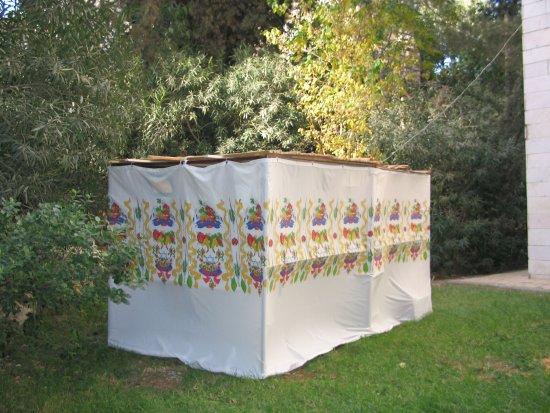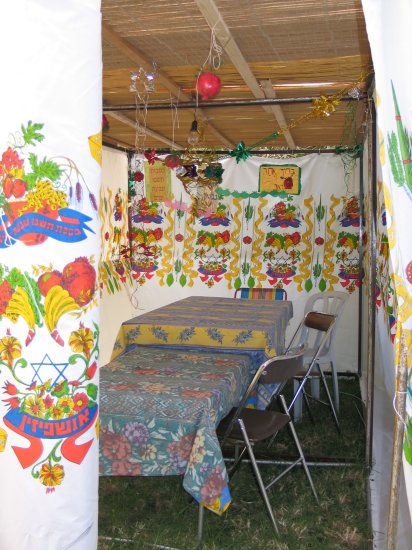Sukkoth: The Jewish Feasts - The Feast of Tabernacles (Booths)
“Also in the fifteenth day of the seventh month, when ye have gathered in the fruit of the land, ye shall keep a feast unto the LORD seven days: on the first day shall be a sabbath, and on the eighth day shall be a sabbath. And ye shall take you on the first day the boughs of goodly trees, branches of palm trees, and the boughs of thick trees, and willows of the brook; and ye shall rejoice before the LORD your God seven days. And ye shall keep it a feast unto the LORD seven days in the year. It shall be a statute for ever in your generations: ye shall celebrate it in the seventh month. Ye shall dwell in booths seven days; all that are Israelites born shall dwell in booths: That your generations may know that I made the children of Israel to dwell in booths, when I brought them out of the land of Egypt: I am the LORD your God” (Lev. 23:29-43)
The Feast of Tabernacles, also called Booths, comes on the fifteenth of Tishri (September-October), the seventh month according to the Jewish (biblical) calendar. This was the third feast that required a pilgrimage to Jerusalem to worship in the Temple and offer sacrifices and offering to the Lord.
“Three times in a year shall all thy males appear before the LORD thy God in the place which he shall choose; in the feast of unleavened bread, and in the feast of weeks, and in the feast of tabernacles: and they shall not appear before the LORD empty: Every man shall give as he is able, according to the blessing of the LORD thy God which he hath given thee” (Deut. 16:16-17).
This is Israel’s Thanksgiving feast in which they acknowledge the Fall harvest and God’s provision for them. It is happy celebration and a time of joy and rejoicing.
This feast also remembers Israel’s deliverance from Egypt and their subsequent wandering in the wilderness for forty years. During this time Israel lived in tents and worshiped at the Tabernacle which was also a tent. To remember this time the Jews build small tabernacles or booths which walls of plaited branches and thatched roofs as God instructed in Leviticus 23:42. Today to fulfill the commandment, sekhakh(booth) is still constructed. It must be made of something that grew from the ground and was cut off, such as tree branches, corn stalks, bamboo reeds, sticks, or two-by-fours and constructed so it will not blow away in the wind. The Sekhakh roof must be left loose, not tied together or tied down. Sekhakh must be placed sparsely enough that rain can get in, and preferably sparsely enough that the stars can be seen, but not so sparsely that more than ten inches is open at any point or that there is more light than shade.
For seven days they were to live in these booths as a vivid reminder of the days in the wilderness living in tents. Further when the came to the Temple they would be carrying an etrog, which was a citrus fruit, which symbolized the fruit of the Promised Land. The Jews also used alulaw, which was made of the branches of palm trees, myrtles and willows tied together with a golden thread. During the celebration in the Temple these lulaw would be waved at certain times during the service.


The Sekhakh (booth) Inside the Sekhakh
While standing, the person picks up the lulav with its attached willows and myrtle in his right hand, holding the lulav so that its spine is toward them. The etrog is picked up in the left hand, next to the lulav, with its tip (pitom) pointing down. The blessings are said: “Blessed are You, O Lord our God, King of the universe, who has sanctified us by His commandments, and instructed us concerning the waving of the palm branch.” Then the shehekeyanu is said: “Blessed are You, O Lord our God, King of the universe, for keeping us in life, for sustaining us, and for helping us reach this day.” The etrog is then turned right side up and shaken with the lulav. Each day of the Feast of Tabernacles, the people in the Temple courtyard would hold their lulavs and make a circular procession around the altar. During the procession they would pray a prayer that came to be known as Hoshanos. It is a prayer for God’s blessing, ending each phrase of the prayer with the word hoshana (“Please save” or “save now!”). On the first six days they would march around the altar one time. On the seventh day they marched around it seven times. Traditionally, Psalm 27 is recited at the service of the Feast of Tabernacles. Bible prophecy tells us that people from the nations of the world will come up to celebrate the Feast of Tabernacles with the Jewish people in Jerusalem.
“And it shall come to pass, that every one that is left of all the nations which came against Jerusalem shall even go up from year to year to worship the King, the LORD of hosts, and to keep the feast of tabernacles. And it shall be, that whoso will not come up of all the families of the earth unto Jerusalem to worship the King, the LORD of hosts, even upon them shall be no rain” (Zech. 14:16-17).
During the Millennium Kingdom when Christ will rule for a thousand years from His throne in Jerusalem all the nations of the earth will be commanded to come and celebrate the Feast of Tabernacles. If they refuse to come, which means that they are not trusting in the Lord for their substance and living. Therefore the Lord will withhold rain from their nation as punishment and the natural result of refusing God’s provision. Further it also pictures that God will not pour out the Holy Spirit on those who refuse His offer of salvation, who are invited to come and receive freely His mercy and grace.
According to God’s instructions on the first day of the feast thirteen bullocks were offered and each day that followed on less bullock was offered which meant that seventy were offered. Two things characterized the Feast of Tabernacle from the other feasts. One was the illumination of the Temple and the other the pouring of a vessel of water into a basin that was located at the base of the altar. First the golden vessel of water was filled at the pool of Sloam and taken to the altar. Next another golden vessel would be filled with wine and they both would be poured together into the basin. The mixed water and wine would flow down a conduit which carried the water to the Brook of Kidron located across from the eastern wall.
This was ritual symbolized the prayer for the Fall rains upon which Israel depended. Second it pictured the coming of the Messiah and His kingdom in which the Holy Spirit would be poured on Israel and believers of all nations. This ritual of water pouring was continued for six days and concluded the Feast of Tabernacles. This last day was called the “Day of the Great Hosanan” (Hoshannah Rabbah). The word “Hoshannah” means to “save now.” and applied to the feast became “Hosanna” which looked forward to the coming of the Messiah.
This makes the event of Jesus entering the city in what is called the ‘Triumphant Entry” come alive for us as we under its significance. John records in John 12:13 that as Jesus entered Jerusalem the people. “ Took branches of palm trees, and went forth to meet him, and cried, Hosanna: Blessed is the King of Israel that cometh in the name of the Lord.” They were crying “Save us, Son of David.” Matthew 21:15 records the chief priest and scribes became gravely upset because this greeting and prayer was reserved only for the coming of the Messiah. Mark records that the people also cried “Blessed be the kingdom of our father David, that cometh in the name of the Lord: Hosanna in the highest.”(Mark 11:10).
Following His entry into Jerusalem Jesus went to the Temple and proclaimed “In the last day, that great day of the feast, Jesus stood and cried, saying, If any man thirst, let him come unto me, and drink. He that believeth on me, as the scripture hath said, out of his belly shall flow rivers of living water.” (John 7:38-39). The words “In the last day” means that this event occurred on the last day of the Feast of Tabernacles.
Another feature of the feast is was illumination of the Temple. The pilgrims who came to the Temple would bring lights and torches. Further the golden lamps stands would also be lighted illuminating the Temple. This too prophetically looked forward to the coming of the Messiah. Jesus the Messiah identified Himself as that saving light in John 8:12 saying “ Then spake Jesus again unto them, saying, I am the light of the world: he that followeth me shall not walk in darkness, but shall have the light of life.”
Paul when he arrived in Antioch in Pisidia (Asia) proclaim this truth to the Jews there saying, “For so hath the Lord commanded us, saying, I have set thee to be a light of the Gentiles, that thou shouldest be for salvation unto the ends of the earth” (Acts 13:47). Paul preached that he was sent to take this light, which was the Gospel of Jesus Christ, unto all the world.
 An ultra-Orthodox Jewish man walks past a sukkah (hut) during the celebration of Sukkot, the Feast of the Tabernacles, in an ultra-Orthodox neighbourhood of Meah Shearim, Jerusalem, Israel, 30 September 2012. The Sukkot feast begins tonight at sunset and commemorates the exodus of Jews from Egypt some 3,200 years ago.
An ultra-Orthodox Jewish man walks past a sukkah (hut) during the celebration of Sukkot, the Feast of the Tabernacles, in an ultra-Orthodox neighbourhood of Meah Shearim, Jerusalem, Israel, 30 September 2012. The Sukkot feast begins tonight at sunset and commemorates the exodus of Jews from Egypt some 3,200 years ago.
Source: bible-truth.org

